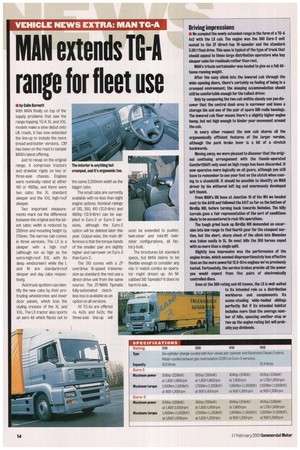Driving impressions
Page 16

If you've noticed an error in this article please click here to report it so we can fix it.
We sampled the newly extended range in the form of a TO-4 4x2 with the LX cab. The engine was the 360 Euro-2 unit mated to the ZF direct-top 16-speeder and the standard 3.08:1 final drive. This spec is typical of the type of truck that should appeal to those large distribution operators who buy sleeper cabs for residuals rather than rest.
MAN's triaxle curtainsider was loaded to give us a full 411tonne running weight.
After the easy climb into the lowered cab through the wide-opening doors. there's certainly no feeling of being in a cramped environment: the sleeping accommodation should still be comfortable enough tor the tallest driver.
Only by comparing the two cab widths closely can you discover that the central dash area is narrower and loses a storage bin and one of the pair of spare DIN radio housings. The lowered cab floor means there's a slightly higher engine hump, but not high enough to hinder your movement around the cab.
In every other respect the new cab shares all the ergonomically efficient features of the larger version, although the park brake lever is a bit of a stretch backwards.
Moving away, we were pleased to discover that the original confusing arrangement with the thumb-operated ComfortShift only used on high range has been discarded. It now operates more logically on all gears. although you still have to remember to use your foot on the clutch when coming to a standstill. It should be possible to identify an MAN driver by his withered left leg and enormously developed left thumb.
From MAN's UK base at Junction 16 of the M4 we headed east to the 4419 and followed the 4417 as far as the bottom of Birdlip Hill, before turning back towards Swindon. The hilly terrain gave a fair representation of the sort of conditions likely to be encountered in real-life operations.
The tough grind back up Bird6p Hill demanded an excursion into low range to find fourth gear for the steepest section, but the short, sharp shock of the climb into Blunsden was taken easily in H. On most hills the 360 horses coped with no more than a single split.
Slightly less impressive was the performance of the engine brake, which seemed disproportionately less effective than on the more powerful 12.8-litre engines we've previously tested. Fortunately, the service brakes provide all the power you would expect from five pairs oh electronically controlled discs.
Even at the 360 rating and 40 tonnes, the LX is well-suited to its intended role as a distribution workhorse and complements its scene-stealing wide-bodied siblings perfectly. But if its intended habitat includes more than the average number of hills. speccing another step or two up the engine rating list will probably pay dividends. I ItKx btAIEN
































































































